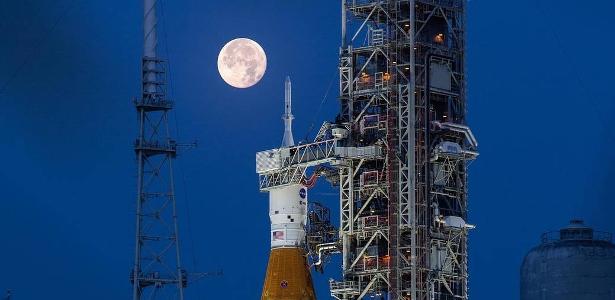
Once again, the launch of the rocket for the Artemis mission was delayed due to NASA. It was originally scheduled for next Tuesday (27). The US Space Exploration Agency announced today (24) that it will have to change its plans due to Tropical Storm Ian.
The weather phenomenon, which was upgraded to Tropical Storm category yesterday (23), is advancing across the Caribbean and is expected to gain more strength in the coming days.
According to the US National Hurricane Center, mathematical models predict that the storm will develop into a hurricane and reach Florida, where the Kennedy Space Center is located, in the middle of next week.
To avoid any potential damage to the SLS (Space Launch System) rocket, NASA is considering securing it in the structure known as the Vehicle Assembly Building (VAB), making it impossible to launch on Tuesday.
“In a Saturday morning meeting, the teams decided to halt launch preparations to allow system configuration to bring the SLS and Orion spacecraft to VAB,” the agency said in a statement.
Also, according to the text, engineers must decide whether to “keep” the missile until tomorrow (25), so that they still have another day to “gather and analyze data” on Ian’s trajectory.
If the vehicle is not stored and remains at the launch point, the mission can still begin on the reserve date already set by NASA: October 2. If it is already transferred to the VAB, the logistics will be more complicated. There are estimates that the next applicable release window will be in December only.
Third postponement
Artemis 1 has been on the platform since mid-August. NASA actually attempted to launch the rocket on August 29 and September 3, but encountered technical problems on both dates.
Over the past week, engineers and technicians have been working to fix a malfunction in the last attempt: a liquid hydrogen leak at the interface between the SLS and the launch tower.
Two seals on this part of the car have been replaced. A long test on Wednesday (21) has proven that the problem has been resolved. All was well on the 27th day…until Ian arrived.
Humans on the Moon in 2026
Artemis is a set of missions that plan to return humans to the Moon, to establish a permanent human presence on the satellite and use it as a springboard for further exploration (particularly Mars).
This first launch is known as Artemis 1. It’s unmanned: it will only serve to send the Orion spacecraft to orbit the moon, gather information, and return.
If this phase succeeds, Artemis 2 is expected to take astronauts to orbit the moon in 2024. Only Artemis 3 will take humans to lunar soil, perhaps in 2025 or 2026.

